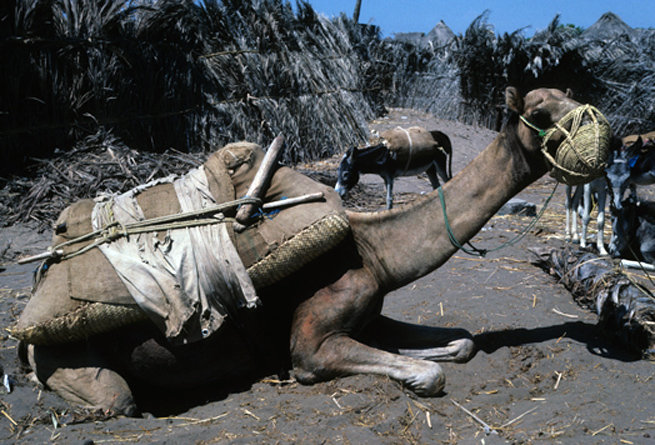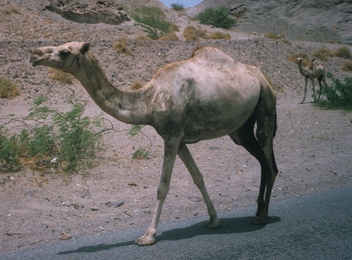
Camels grazing in the Yemeni Tihama, 1978. Photograph by Daniel Martin Varisco
Last Update 1/14
This website is a supplement to my article published in Camels in Asia and North Africa: Interdisciplinary perspectives on their significance in past and present edited by Eva-Maria Knoll & Pamela Burger (Vienna: Austrian Academy of Sciences, 2012).
CONTENTS |
Camel grazing near Aden, Yemen, 1987. |
Article abstract: What do camels eat? The simple answer is almost anything. In the extensive lore on the camel in Arabic texts, there is a wide variety of information about the kind of plants that camels eat, what are considered the best pasture, which produce the best quality milk and some that are thought to cause harm. This study focuses on the ways in which the early Arab botanical genre classified plants for camel pasturage and the experiential information available in these texts and other lexical sources in comparison to ethnographic analysis of camel nomadism on the Arabian Peninsula. Since it is not always possible to determine the contemporary scientific designation of an Arabic plant name used over twelve centuries ago, it is important to compare the historical data with modern botanical research. The main objective of this study is to show the potential for analysis of plants noted in the texts to be consumed or avoided by camels in Arabia. My focus is limited to Camelus dromedarius, the one-humped dromedary common in the Arabian Peninsula and North Africa.
Plants to be Avoided or Dangerous to Camels
The listing here is for information purposes only and to facilitate further research. The transliteration is that of the source. If you find any errors or have new plants to add to the list, please contact me at daniel.m.varisco@hofstra.edu. More information on why certain plants are dangerous or avoided can be found in the article. Note that Arabic plant names vary widely, both over time and by location and the same Arabic term may be used for different plants. The article discusses nomenclature issues.
| Scientific Classification | Arabic Term | Source |
| Aerva javanica | Gauthier-Pilters 1981:46 | |
| Allium sphaerocephalum | karrāth, kirrēth | Saudi Arabia: Mandaville 2011:99 |
| Artemesia sp. | ādhir | Northern Nejd: Great Britain Admiralty 1946:510 |
| Anthemis cotula | farākh umm ‘Alī | Murād 2005:147 |
| Asphodelus tenuifolius | barwag, bērag | Saudi Arabia: Mandaville 2011:99 |
| Atropa belladonna | sitt al-ḥasan | Murād 2005:146 |
| Calendula tripterocarpa | ḥanwah | Saudi Arabia: Mandaville 2011:98 |
| Calotropis procera | ‘ushar, ‘ishar | Saudi Arabia: Mandaville 2011:98 [also Gauthier-Pilters 1981:46] |
| Cassia italica | ishrig, shajarat al-dābb | Saudi Arabia: Mandaville 2011:98 [also Gauthier-Pilters 1981:45] |
| Citrullus colocynthis | ḥanẓal | Murād 2005:147; Saudi Arabia: Mandaville 2011:99; Egypt: Hobbes 1989:93 |
| Cymbopogon commutatus | sāf, sakhbar, , idhkhir | Saudi Arabia: Mandaville 2011:99 |
| Danthonia forskhalii | Gauthier-Pilters 1981:45 | |
| Datura metel | khurū‘ | Murād 2005:147 [also Gauthier- Pilters 1981:46] |
| Delphinium ajacis | ‘ā’iq | Murād 2005:146 |
| Euphorbia calyptrata | Gauthier-Pilters 1981:46 | |
| Euphorbia granulata | labnah, ḥillab | Saudi Arabia: Mandaville 2011:98 |
| Euphorbia peplus | zaghlanat? | Murād 2005:146 |
| Euphoriba retusa | ghazālah | Kuwait: Mandaville 2011:98 |
| Genista saharae | Gauthier-Pilters 1981:45 | |
| Gynandriris sisyrinchium | ‘unṣēl | Kuwait: Dickson in Mandaville 2011:99 |
| Halocnemum strobilaceum | thillēth | Kuwair: Dickson in Mandaville 2011:98 |
| Heliotropium ramosissimum | ghubayr | Murād 2005:146 |
| Hyoscyamus falezlez | Gauthier-Pilters 1981:46 | |
| Hyoscyamus muticus | banj | Murād 2005:146 |
| Linum usitatissimum | kattān | Murād 2005:147 |
| Lolium temulentum | ḥashīsha al-fars | Murād 2005:147 |
| Lotus arabicus | Murād 2005:147 | |
| Lotus jolyi | Gauthier-Pilters 1981:45 | |
| Lupinus varius | turmus | Murād 2005:146 |
| Melilotus indicus | ḥandaqūq | Murād 2005:147 |
| Nerium oleander | difla, ward kadhdhāb | Murād 2005:147; Saudi Arabia: Mandaville 2011:98 [also Gauthier- Pilters 1981:45] |
| Nicotiana glauca | Murād 2005:147 | |
| Peganum harmala | ḥarmal | Murād 2005:146 |
| Pergularia tomentosa | Gauthier-Pilters 1981:44 | |
| Perralderia coronopifolia | Gauthier-Pilters 1981:44 | |
| Phalaris minor var. haematites | Gauthier-Pilters 1981:45 | |
| Prosopis stephaniana | shalshalawī? | Murād 2005:147 |
| Pulicara undulata | jathjāth | Saudi Arabia: Mandaville 2011:99 |
| Ranunculus sceleratus | zaghlīl | Murād 2005:147 |
| Retama raetem | Gauthier-Pilters 1981:45 | |
| Rhazya stricta | ḥarmal | Great Britain Admiralty 1946:510; Saudi Arabia: Mandaville 2011:99 |
| Rumex dentatus | ḥumayḍa | Murād 2005:147 |
| Solanum nigrum | ‘inab al-dhi’b | Murād 2005:147 |
| Trignonella stellata | nafal, shmaṭrī | Saudi Arabia: Mandaville 2011:98 |
| Withania somnifera | wasm al-farākh | Murād 2005:147 |
| Xanthium spinosum | shubīṭ? | Murād 2005:147 |

Camel resting in the sūq of Bayt al-Faqīh, the Yemeni Tihāma, 1987. Photography by Daniel Martin Varisco
References cited on this webpage
Gauthier-Pilters, Hilde and Anne Innis Dagg
1981 The Camel: Its Evolution, Ecology, Behavior, and Relationship to Man. Chicago: The University of Chicago Press.
Great Britain Admiralty
1946 Western Arabia and the Red Sea. B.R. 527. London: Naval Intelligence Staff, Great Britain Admiralty.
Hobbes, Joseph L.
1989 Bedouin Life of the Egyptian Wilderness. Austin: University of Texas Press.
Mandaville, James P.
2011 Bedouin Ethnobotany: Plant Concepts and Uses in a Desert Pastoral World. Austin: University of Texas Press.
Murād, Muṣṭafā Muḥammad
2005 Malāmiḥ fī taghdhiyā al-ibl wa-tarbīyathā. Al-‘Ayn: Markaz Zāyid li-al-Turāth wa-al-Ta’rīkh.
New References (since article was published)
Mandaville, James P.
2011 Bedouin Ethnobotany: Plant Concepts and Uses in a Desert Pastoral World. Austin: University of Texas Press.
[This superb study appeared after the article was in proof stage. It provides a wide range of information on plants that camels graze on as well as are toxic or avoided. This is the best source in English on Arabian Bedouin plant lore with scientific identification where possible.]
Site created by Daniel Martin Varisco on July 1, 2012
